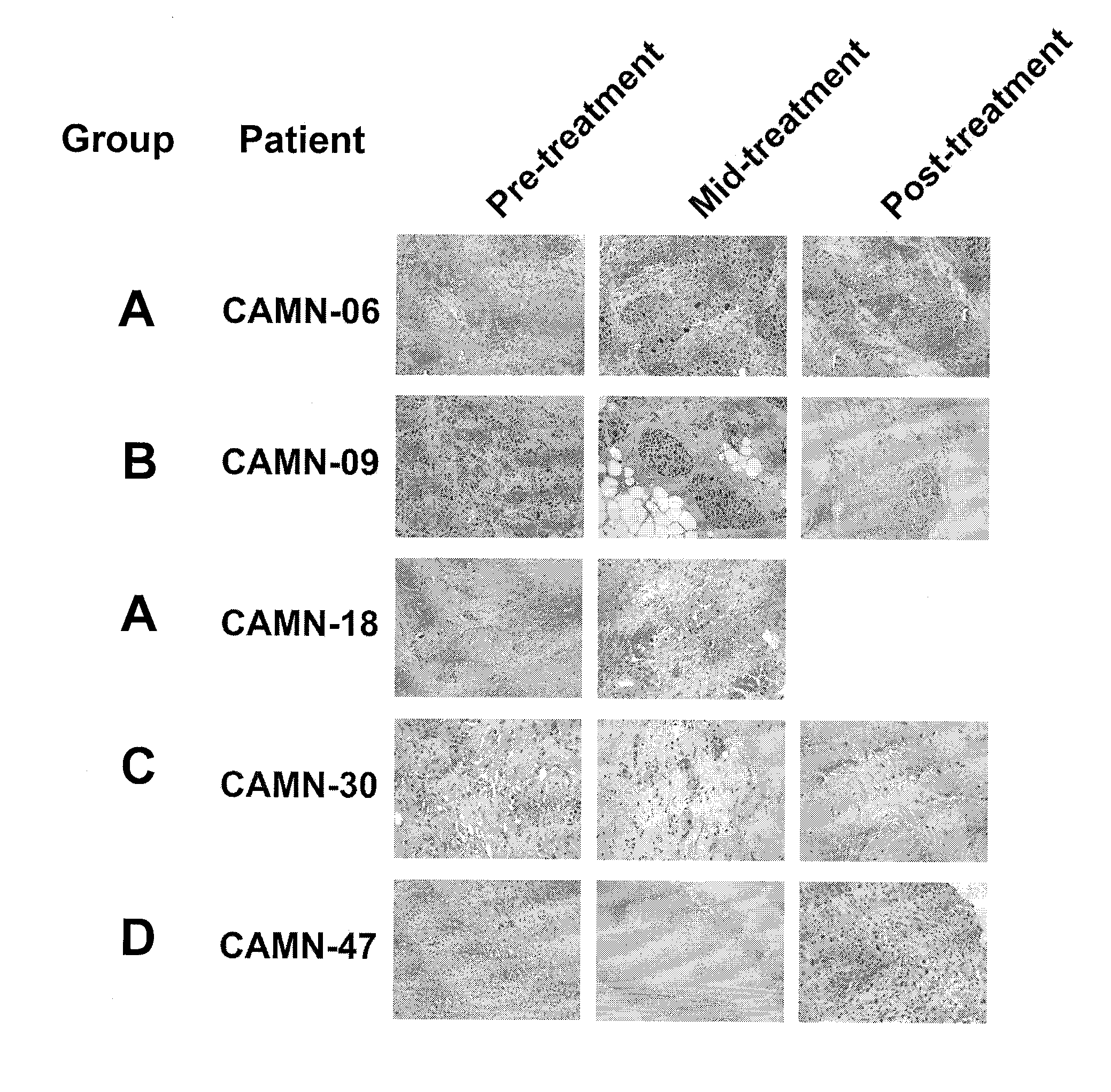Method of using tumour RNA integrity to measure response to chemotherapy in cancer patients
a technology of tumour rna integrity and tumour, which is applied in the field of determining the response of tumours to chemotherapy, can solve the problems of destroying both healthy normal cells (particularly), interfering with dna replication in rapidly dividing tumour cells, and using chemotherapy is highly cytotoxic, so as to achieve rapid and accurate assessment of the response of tumours, and rapid assessment of tumour rin
- Summary
- Abstract
- Description
- Claims
- Application Information
AI Technical Summary
Benefits of technology
Problems solved by technology
Method used
Image
Examples
example 1
Materials and Methods
[0053](a) Total RNA Isolation from Breast Tissue Core Biopsies.
[0054]RNA was isolated from patient tumour core biopsies using QIAGEN® RNAeasy® mini kits (Qiagen GmbH, Germany). The RNA isolation protocol was slightly modified from the protocol published by Qiagen GmbH (freely available from Qiagen GmbH, Germany; also available at http: / / www1.qiagen.comiliterature / handbooks / literature.aspx?id=1000291).
[0055]Image-guided needle core biopsies of the patients tumour were taken from the patient, immediately touch prepared to a glass slide for determination of tumour cellularity, and the core biopsy immediately flash frozen on dry ice for future analysis. The frozen core biopsies were immediately dropped in 0.5 ml of RLT buffer containing β-ME (10 μl into 1 ml) in a Eppendorf tube. The biopsies in RLT buffer were homogenized with a Coreless™ motor homogenizer for 5 min (Kontes Glass Company, U.S.A., Cat#:749540-0000).
[0056]The lysate was then passaged at least 5 times...
example 2
The RNA Integrity Number (RIN) and Measurement of Tumour RNA Quality in Breast Cancer Patients
[0067](a) Tumour Biopsy Samples from Breast Cancer Patients in Chemotherapy Clinical Trial
[0068]To test whether treatment of breast cancer patients with chemotherapy agents results in tumour RNA degradation, six image-guided core biopsies of tumours were taken from 50 patients with locally advanced or inflammatory breast cancer pre-, mid-, and post-treatment with epirubicin / docetaxel chemotherapy. Patients were from a national clinical trial hosted by the National Cancer Institute of Canada Clinical Trials Group (referred to as group “MA.22”) and were treated with increasing dose levels of both epirubicin and docetaxel, with pegfilgrastim support to reduce neutropenia associated with this therapy. Chemotherapy was administered in a standard dosing regimen (Arm A) every 3 weeks, and the dose levels used in this study are depicted in Table 1. The maximum tolerated dose for this regimen was do...
example 3
Use of Tumour RNA Quality to Determine a Cancer Patient's Responsiveness to a Chemotherapy Regimen
[0084]According to the method of Example 1, RNA is extracted from tumour cells of a cancer patient with one or more tumours at two or more different time points during the administration of a chemotherapy regimen, before the administration of a chemotherapy regimen, and during and / or after completion of the regimen.
[0085]The tumour cells are collected in one or more image-guided biopsies. An image-guided biopsy is obtained with image-guided means such as computed tomography (CT), x-ray, ultrasound, and magnetic resonance imaging (MRI).
[0086]The quality of the extracted RNA is then determined by capillary electrophoresis of the extracted RNA and quantification of the RNAs in the resultant electropherogram. An automated analytical system, such as the Agilent® 2100 Bioanalyzer (Agilent Technologies, Inc., U.S.A.) is used for carrying out the RNA quality determination, in order to obtain an...
PUM
| Property | Measurement | Unit |
|---|---|---|
| diameter | aaaaa | aaaaa |
| spectroscopy | aaaaa | aaaaa |
| electrophoresis | aaaaa | aaaaa |
Abstract
Description
Claims
Application Information
 Login to View More
Login to View More - R&D
- Intellectual Property
- Life Sciences
- Materials
- Tech Scout
- Unparalleled Data Quality
- Higher Quality Content
- 60% Fewer Hallucinations
Browse by: Latest US Patents, China's latest patents, Technical Efficacy Thesaurus, Application Domain, Technology Topic, Popular Technical Reports.
© 2025 PatSnap. All rights reserved.Legal|Privacy policy|Modern Slavery Act Transparency Statement|Sitemap|About US| Contact US: help@patsnap.com



